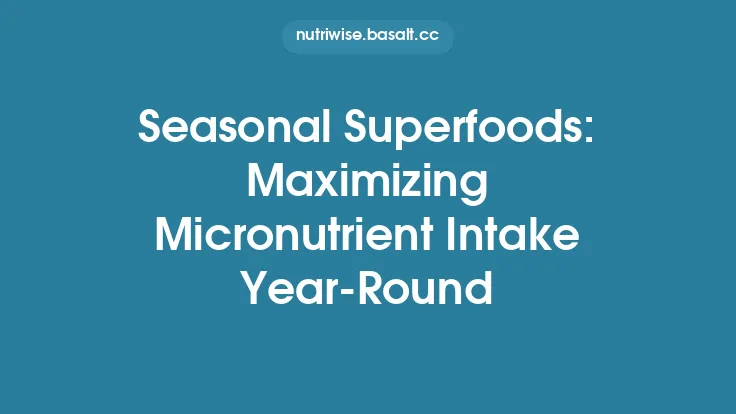Fermented foods are celebrated not only for their complex flavors but also for the living microorganisms they contain. While the initial fermentation process determines which strains dominate, the way you store and handle these foods afterward can dramatically influence how many viable probiotics remain when you finally enjoy them. Understanding the factors that affect probiotic survival—temperature, oxygen exposure, moisture, pH, and even the container material—allows you to preserve the health‑boosting potential of your ferments for months, and sometimes even years.
The Microbial Lifecycle After Fermentation
Once a batch of sauerkraut, kimchi, pickles, or any other vegetable ferment reaches its target acidity, the microbial community enters a quasi‑steady state. The dominant lactic acid bacteria (LAB) such as Lactobacillus plantarum, L. brevis, and Leuconostoc mesenteroides continue to metabolize residual sugars, producing additional acids, carbon dioxide, and small amounts of bacteriocins that inhibit spoilage organisms. Over time, however, several processes can erode probiotic counts:
- Cellular Senescence – Even robust LAB eventually enter a stationary phase where metabolic activity slows and cell membranes become more permeable.
- Autolysis – Enzymes released by dying cells can break down neighboring viable cells, reducing overall counts.
- Environmental Stress – Fluctuations in temperature, pH drift, and exposure to oxygen can trigger stress responses that either protect or kill cells, depending on the strain’s resilience.
The goal of proper storage is to minimize these degradative forces while maintaining the organoleptic qualities that make fermented foods enjoyable.
Temperature Management: The Single Most Critical Variable
Refrigeration (0 °C – 4 °C)
- Probiotic Preservation: Most LAB remain viable for 3–6 months at typical refrigerator temperatures, with a gradual decline of 0.5–1 log CFU per month. The cold slows metabolic activity, reducing autolysis and limiting the production of off‑flavors.
- Practical Tips:
- Store ferments in the main compartment rather than the door, where temperature swings are greatest.
- Avoid placing jars near raw meat or strong‑smelling foods; volatile compounds can permeate through plastic lids and affect flavor.
Freezing (–18 °C and below)
- Probiotic Viability: Freezing can arrest cellular metabolism almost completely, preserving counts for 12 months or longer. However, ice crystal formation can damage cell walls, especially for strains lacking robust exopolysaccharide (EPS) matrices.
- Best Practices:
- Portion ferments into smaller, airtight containers or freezer‑grade zip bags to reduce thaw cycles.
- Add a thin layer of brine (or a small amount of glycerol, 2–5 % w/v) before sealing; the extra water activity helps protect cell membranes during freezing.
- Thaw slowly in the refrigerator, not at room temperature, to avoid a sudden temperature shock that can cause rapid cell death.
Room Temperature (15 °C – 22 °C)
- Short‑Term Use: If you plan to consume a ferment within a week or two, keeping it at cool room temperature (e.g., a pantry or cellar) is acceptable. Viability loss is modest (≈0.2 log CFU per week) but flavor development continues, often becoming more pronounced.
- Caution: Prolonged storage above 22 °C accelerates both probiotic decline and the risk of spoilage organisms outcompeting the beneficial bacteria.
Oxygen Exposure: The Role of Anaerobiosis
Most LAB are facultative anaerobes; they thrive in low‑oxygen environments but can tolerate limited exposure. However, oxygen can:
- Oxidize Sensitive Metabolites: Certain vitamins (e.g., B₂) and flavor compounds degrade, diminishing both health benefits and taste.
- Promote Growth of Aerobic Spoilers: Molds and yeasts can colonize the surface if oxygen penetrates the container.
Strategies to Minimize Oxygen
- Submerge the Food: Ensure that vegetables are fully covered by brine. Use a fermentation weight or a clean, food‑grade stone to keep them below the liquid surface.
- Seal Tightly: Glass jars with screw‑on lids and a rubber gasket (e.g., Mason jars) provide an effective barrier. For larger batches, food‑grade plastic buckets with airtight lids work well.
- Headspace Management: Leave minimal headspace to reduce the volume of air trapped. If a larger headspace is unavoidable, purge the jar with an inert gas (e.g., nitrogen) before sealing.
Moisture and Salt: Balancing Water Activity
Salt Concentration
- Typical Range: 2 %–3 % (w/v) for vegetable ferments. This level creates an environment where LAB can flourish while inhibiting most pathogens.
- Impact on Probiotic Potency: Higher salt slows bacterial metabolism, extending shelf life but also reducing the rate at which probiotic counts increase during storage. Conversely, too low a salt level can lead to rapid fermentation, quicker acid buildup, and eventual cell death from low pH.
Water Activity (a_w)
- Definition: The ratio of the vapor pressure of water in the food to that of pure water. LAB generally require a_w > 0.95.
- Control: Adding a modest amount of sugar (1 %–2 % w/v) can raise a_w slightly, supporting probiotic survival without compromising the low‑sugar ethos of many ferments. However, be mindful of the final product’s intended dietary profile.
Container Materials: Glass vs. Plastic vs. Ceramic
| Material | Oxygen Permeability | Interaction with Acids | Longevity of Probiotic Viability |
|---|---|---|---|
| Glass (borosilicate or soda‑lime) | Near‑zero | Inert; no leaching | Excellent; ideal for long‑term storage |
| Food‑grade HDPE/PP Plastic | Low but measurable | Generally inert; some plastics may leach additives over years | Good for short‑term (≤3 months); avoid for extended storage |
| Ceramic (glazed) | Near‑zero | Glaze may contain lead or cadmium if not food‑grade | Acceptable if glaze is certified; otherwise, prefer glass |
Recommendation: For the longest probiotic preservation, use glass jars with airtight lids. If you must use plastic (e.g., for large‑volume fermenters), select BPA‑free, food‑grade containers and replace them every 6–12 months to avoid micro‑cracks that can harbor oxygen.
pH Monitoring: Knowing When the Ferment Is “Done”
- Target pH: Most vegetable ferments are considered safe and probiotic‑rich when the pH drops below 4.2. Below this threshold, pathogenic bacteria such as Clostridium botulinum cannot grow.
- Probiotic Viability Curve: Viable counts typically peak when pH reaches 3.5–3.8, then gradually decline as the environment becomes too acidic for even hardy LAB.
- Practical Approach:
- Use a calibrated pH meter or high‑quality test strips to check the ferment after the initial 7‑10 days.
- If the pH is already below 3.5, consider transferring the batch to the refrigerator to halt further acidification and preserve probiotic numbers.
- For ferments that remain above 4.2 after two weeks, extend the fermentation at a cooler temperature (e.g., 15 °C) until the desired acidity is achieved.
“Reviving” Dormant Probiotics: The Power of Re‑Fermentation
Even after months in the refrigerator, many LAB remain in a dormant but viable state. You can stimulate a modest resurgence of activity by:
- Adding a Small Amount of Fresh Brine: Introduce a fresh, lightly salted solution (1 %–2 % salt) to the jar, stirring gently. This raises the water activity and provides a new substrate for the bacteria.
- Temperature Shift: Move the jar to a cooler room temperature (≈18 °C) for 24–48 hours, then return it to the fridge. The brief warm period can “wake up” cells without allowing spoilage organisms to proliferate.
- Inoculation with a Fresh Starter: If you have a live culture (e.g., a spoonful of kefir grains or a commercial probiotic capsule), sprinkle a tiny amount into the ferment. This can boost counts, especially for strains that may have dwindled.
Serving Strategies That Preserve Probiotic Load
- Portion Control: Scoop out only the amount you intend to eat. Re‑seal the jar promptly to limit oxygen exposure.
- Cold Serving: Serve ferments chilled. Warm temperatures accelerate bacterial metabolism, which can lead to rapid pH decline and loss of texture.
- Avoid Heat: Adding fermented foods to hot soups or stir‑fries can kill up to 90 % of the probiotic population if the temperature exceeds 45 °C. Instead, add them at the end of cooking or use them as a cold garnish.
- Combine with Prebiotic Foods: Pairing fermented vegetables with fiber‑rich foods (e.g., whole‑grain crackers, cooked legumes) supplies the gut microbiota with substrates that support the survival of ingested probiotics after they pass through the stomach.
Shelf‑Life Estimation: How Long Do Probiotics Remain Potent?
While exact numbers depend on strain, salt level, and storage conditions, the following general guidelines apply:
| Storage Condition | Approximate Viable Count Retention* |
|---|---|
| Refrigerated (4 °C) | 70 %–85 % after 3 months; 40 %–60 % after 6 months |
| Freezer (–18 °C) | 80 %–95 % after 12 months (if properly packaged) |
| Cool Room (18 °C) | 60 %–70 % after 2 weeks; rapid decline thereafter |
| Warm Room (≥25 °C) | 30 %–50 % after 1 week; often unsuitable for >2 weeks |
\*Retention expressed as a percentage of the initial viable count measured at the end of primary fermentation (typically 10⁸–10⁹ CFU g⁻¹).
Troubleshooting Common Storage Issues
| Symptom | Likely Cause | Corrective Action |
|---|---|---|
| Mushy texture | Excessive water activity or low salt; bacterial over‑growth of Lactobacillus casei which produces proteases | Increase salt to 2.5 %–3 %; ensure vegetables are fully submerged; store at colder temperature |
| Off‑flavors (yeasty, alcoholic) | Yeast contamination due to oxygen ingress | Tighten lid, add a weight, purge headspace with nitrogen; discard if mold appears |
| Surface mold | Inadequate brine coverage or prolonged exposure to air | Remove mold, add fresh brine, re‑seal; consider using a fermentation lid that releases CO₂ while blocking air |
| Rapid pH drop after opening | Residual active LAB continue metabolizing sugars in the opened jar | Transfer remaining ferment to a smaller, airtight container; keep refrigerated; consume within a week |
Integrating Fermented Foods into a Probiotic‑Rich Lifestyle
To reap the maximum health benefits, consider the following routine:
- Daily Dose: Aim for 2–4 tablespoons of a mixed‑vegetable ferment per day. This provides a steady influx of live cultures without overwhelming the gut.
- Variety: Rotate between different ferments (e.g., carrot pickles, fermented beets, radish kimchi) to expose the microbiome to a broader spectrum of strains.
- Timing: Consume ferments on an empty stomach or between meals to reduce gastric acid exposure, which can improve survival of the bacteria through the stomach.
- Complementary Prebiotics: Pair with foods high in inulin (e.g., chicory root, Jerusalem artichoke) or resistant starch (e.g., cooled cooked potatoes) to nourish the probiotic strains once they colonize the colon.
Final Checklist for Maximizing Probiotic Potency
- [ ] Verify brine covers all vegetables; use a weight if needed.
- [ ] Seal jars airtight; consider a fermentation lock for long‑term storage.
- [ ] Store at 0 °C – 4 °C for most ferments; freeze only if you need >6 months of shelf life.
- [ ] Keep headspace minimal; purge with inert gas if possible.
- [ ] Monitor pH; aim for 3.5 – 4.2 before refrigeration.
- [ ] Use glass containers for best long‑term preservation.
- [ ] Portion and reseal quickly; avoid heating above 45 °C.
- [ ] Pair with prebiotic foods and consume regularly.
By treating fermented foods not just as a one‑time culinary experiment but as a living product that requires thoughtful stewardship, you can preserve their probiotic power for months on end. The result is a pantry stocked with flavorful, gut‑friendly foods that support digestion, immunity, and overall well‑being—long after the initial fermentation is complete.





